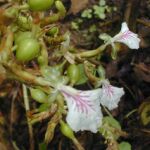| Common Name: |
Cardamon |
| Other Names: |
Bastard Cardamom, Cardamom, Capalga, Elettari, Malabar Cardamom |
| Botanical Name: |
Elletaria cardamomum |
| Genus: |
Elletaria |
| Family: |
Zingiberaceae |
| Native Location: |
India, Sri Lanka |
| Cultivation: |
Rich, moist, well-drained soil in sun or partial shade. Plants grown under cover may suffer from spider mite. Prone to mosaic virus and thrips in the tropics. |
| Propagation: |
By seed sown when ripe at 19-24°C (66-75°F); by division in spring. |
| Harvest: |
Fruits are collected during the dry season and dried whole; seeds are removed for oil extraction or used in infusions, liquid extracts, powders and tinctures. |
| Height: |
3m (10ft) |
| Width: |
3m (10ft) |
| Hardiness: |
Min. 10°C (50°F) |
| Extraction: |
Steam Distillation |
| History: |
Cardamom, native to India and Ceylon, is most famous as a culinary herb and is a key ingredient in India's famous spice mixture garam marsala, as well as the distinctive flavoring in may international dishes: Indian curries, African casseroles, Middle Eastern rice pilafs, Danish breads and pastries, and Arabic coffees. In the West cardamom is not well known for its medicinal value. In the East, however, a variant of true cardamom has been used in Chinese herbal medicine for 2,000 years. The fertile seeds of Chinese cardamom (Amomum cardamomum), called sha ren, are used to treat bowel obstructions, diarrhea, and vomiting. The infertile seeds of A. cardamomum, called bai dou kou, are used to relieve abdominal bloating and indigestion. |
| Parts Used: |
Seeds, oil |
| Color and Odor: |
The essential oil is pale yellow with an agreeable, warm, sweet and spicy aroma. |
| Background: |
Cardamon has a long history of use in India. Also known to the ancient Egyptians and used by the Greeks and Romans. The Arabs later also recognized its digestive properties, often grinding it with their coffee. Cardamon is popular in Eastern European countries. |
| Properties: |
Warming, tonic, stimulant, refreshing, invigorating, digestive, aphrodisiac.
A pungent, warm, aromatic herb that has stimulating, tonic effects, especially on the lungs and kidneys. It relaxes spasms, is expectorant, and improves digestion. Reputedly aphrodisiac, it also detoxifies caffeine and counteracts mucus-forming foods, such as dairy products. |
| Planet: |
Venus |
| Element: |
Water |
| Magical Influences: |
Love, Sex. |
| Medicinal Uses: |
Internally for indigestion, nausea and vomiting, enuresis, and pulmonary disease with copious phlegm. Used in Ayurvedic medicine for bronchial and digestive complaints. Seeds are chewed to sweeten breath.
Cardamom is a mild stimulant, an antispasmodic, an expectorant, and an excellent digestive aid. Traditionally it is used to treat bronchial ailments, diarrhea, flatulence, indigestion, intestinal cramping, nausea, stomach cramps, and vomiting. It is especially effective in relieving the stomach and intestinal ailments that often accompany a long illness or general debilitation and weakness. |
| Culinary Uses: |
Seeds are used to flavor baked goods (especially in N Europe), coffee (Middle East), curries, pickles, milk-based desserts, fruit compôtes, and mulled wine. An ingredient of the Ethiopian hot spice blend mit'mit'a. |
| Economic Uses: |
Essential oil is important in perfumery. |
| Preparation: |
Cardamom is widely available as whole seeds and ground or powdered seeds; it may sometimes be found in tea form (usually in combination with other herbs). The seeds may be chewed—one at a time—to relieve flatulence, indigestion, and nausea, and also to freshen the breath. Add a teaspoon of cardamom seeds to warm bathwater for a mildly stimulating herbal soak that can help relieve stomach cramps. To make a decoction, consult your practitioner about the best way to use the herb. (Adding the herb to boiled water must be done carefully or the herb loses much of its medicinal value.) |
| Warning: |
This herb, as a tincture, is subject to legal restrictions in some countries. |
| Uses: |
- Digestive System—A digestive aid, cardamon corrects indigestion and gastric fermentation. It is good for flatulence and freshens the breath. Cardamon is mainly recommended for chronic indigestion with bloating, belching, flatulence and hiccups. It is an effective remedy for heartburn as it relieves pressure in the chest caused by swollen stomach pressing on the diaphragm.
- Urinary System—As a diuretic, cardamon remedies urine retention and can cure gout.
- Emotions—Cardamon's distinct, uplifting and lightening effect helps to clear the mind of confusion. Cheers the heart and counters selfishness. Stimulates the mind to enable clear thinking.
|
| Blends: |
| DIGESTIVE |
URINARY |
EMOTION |
| Cardamon 5 |
Cardamon 5 |
Cardamon 5 |
| Ginger 3 |
Celery 4 |
Basil 3 |
| Parsley 3 |
Fennel 3 |
Lemon 3 |
| Bibliography: |
Aromatherapy Blends and recipes by Franzesca Watson Copyright © 1995 Thorsons, Harper Parker Publishing Inc. Pp 74-75
Magical Aromatherapy by Scott Cunningham Copyright © 1989 Llewellyn Publications, Inc. pp.68-69
The Encyclopedia of Herbs by Deni Brown Copyright © 1995, 2001 Dorling Kindersley Limited. pg 200.
The Modern Herbal Primer by Nancy Burke Copyright©2000 Yankee Publishing, Inc. pg.46 |
|

